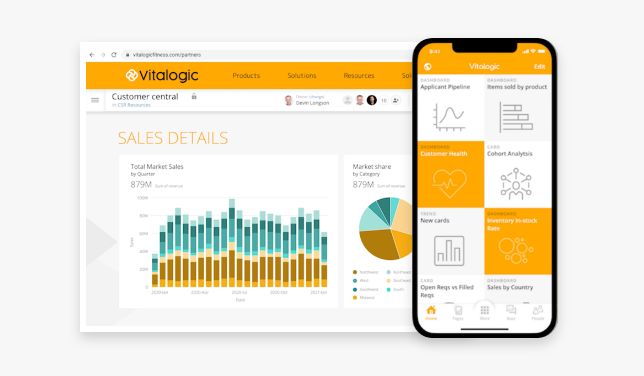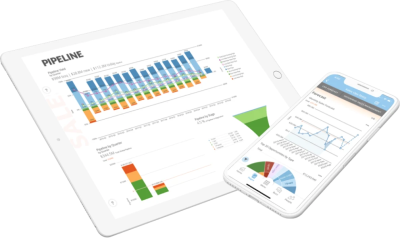Learn how to supercharge your data with embedded BI dashboards and reports
Most business owners are data-driven. They need to make quick, informed decisions in order to stay ahead of the competition. And to do that, they need access to the right data at the right time.
Unfortunately, most business owners rely on spreadsheets and other manual methods to track their data. While this may be the tried and true method to track data, it’s not the most efficient way to do so.
With the increase in data creation and the growing number of users, traditional methods simply do not cut it anymore. Fortunately, there’s a better way: embedded business intelligence (BI) dashboards and reports.

What are embedded BI dashboards and reports?
Embedded BI dashboards and reports allow you to add reporting capabilities directly within your existing or custom-built applications. This provides the ability to make better business decisions when big data comes into play.
Since embedded BI dashboards and reports are contained within integrated applications, it allows for flexibility and choice when it comes to your data sources. You can choose from a number of different databases and cloud-based applications to create an embedded BI dashboard or report.
What does an embedded BI dashboard offer?
Embedded BI dashboards allow you to view your data in a whole new light. When data is embedded directly into an application, it’s easier for professionals like sales managers and HR personnel to access the information while they’re on the go. Embedded dashboards can also be used to surface important data to customers and partners outside your organization, which can improve your business relationships and even provide you with new revenue streams by sharing your valuable data.
Embedded BI dashboards offer real-time insights into critical data and can display information such as:
Business KPIs: These include sales leads, total customer revenue, and the number of abandoned carts.
Sales numbers: Timely information about your sales can help you to adjust strategies and allocate resources accordingly.
Employee performance: Managers and directors need to know how employee performance stacks up against their peers. And embedded BI dashboards can provide that information in real-time.
What about embedded BI reports?
Embedded reports provide easy distribution of key performance indicators (KPIs) at a moment’s notice.
This makes it easier for decision-makers to access information as soon as it becomes available rather than waiting for the next scheduled report. This flexibility helps to provide a competitive edge.
In addition, embedded BI reports can save you money by offloading data storage to the cloud where it’s easily accessible from anywhere. With reporting capabilities built right into your existing applications, you can save time and resources that teams would have spent duplicating information.

Embedded BI dashboards and reports versus spreadsheets for business intelligence
Spreadsheets are the traditional approach to store and track data, but they don’t provide the flexibility that business owners need in order to make informed decisions on their data. This traditional data tracking method only provides the ability to view your data in one simple, straightforward format.
However, embedded BI dashboards and reports offer more than just real-time access to information; they also allow users to quickly identify business trends by modifying how your data is displayed on an individual or group basis.
And with cloud storage capabilities for easy access, embedded BI dashboards and reports provide the ability to track your data from anywhere.
Examples of embedded BI dashboards and reports
There are numerous tools on the market today that offer embedded BI dashboards and reports. Here are some examples of how different businesses can use these features to their advantage:
Marketing: Embedded BI dashboards and reports can help marketing teams to gather insight into their customers. Armed with this information, they can make better decisions about targeting customers and reducing risk when it comes to profits and lead generation.
Customer service: Customer service managers need both timely and relevant data to serve customers quickly and effectively. Embedded BI dashboards and reports can help improve customer satisfaction rates while simultaneously boosting profits.
Finance: Financial professionals are required to make critical financial decisions on a daily basis. They must have access to KPIs, sales numbers, and revenue information in order to track their performance against market standards. Embedded BI dashboards and reports can help make this information easily accessible.
Sales: Sales managers need to identify trends in customer behavior over time; embedded BI dashboards and reports provide real-time access to sales numbers while streamlining data analysis efforts. This makes it easier for leaders to take advantage of pricing changes, inventory management, and seasonal opportunities.
Human resources: Embedded BI dashboards and reports can provide human resource departments with the information they need to build better teams. By capitalizing on employee strengths, managers can increase profits for their company while simultaneously taking advantage of embedded BI dashboards and reports’ ability to provide real-time performance data.
Implementing embedded BI dashboards and reports
The benefits of an embedded BI dashboard and reports are clear. But how can you make this capability a reality?
The first step is to identify the right data sources.
Cloud-based tools that offer embedded BI dashboards and reports typically provide integration capabilities with popular applications like Salesforce, Oracle, Microsoft Dynamics CRM, QuickBooks Online, Slack, and more.
Once you’ve identified your data sources, it’s time to consider your business needs and find the tools that can provide the best solution for your company.
Managers should keep in mind that there are different types of embedded BI dashboards and reporting tools on the market today that vary based on their capabilities. For this reason, it’s important to put into consideration your company’s unique needs and find the right tool for you.
Once you’ve determined what features you need, choose a provider that can provide your organization with comprehensive embedded BI dashboards and reports capabilities.
Also, remember to look for vendors that can integrate easily with other tools to provide business owners with a complete and cohesive collection of data.
Once you’ve found your tools and vendors, the next step is to implement them into your business processes.
This may involve making necessary changes to effectively integrate embedded BI dashboards and reports into your system. In some cases, it’s wise to hire outside help to test these types of integrations.
Once implemented, your company’s ability to provide real-time data will give it a competitive advantage in today’s business environment.
Conclusion
Embedded BI dashboards and reports are optimal for businesses to gather insight into their customers, improve customer service efforts, make financial decisions with speed and accuracy, track sales numbers, and more.
By offering a dynamic and visual way to look at complex data, embedded BI dashboards and reports enable managers to take action on relevant information as it happens.
Check out some related resources:

Business Intelligence Strategy: Development, Best Practices, and Examples

The 11 Best Big Data Analytics Tools in 2025






